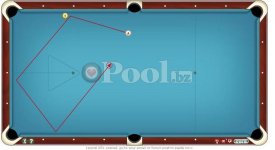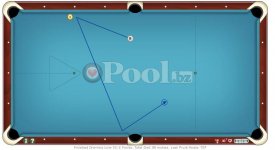You are using an out of date browser. It may not display this or other websites correctly.
You should upgrade or use an alternative browser.
You should upgrade or use an alternative browser.
Noob question but I can't make a ball frozen to rail with inside bottom, why?
- Thread starter Magyar19
- Start date
Am I to understand that you're attempting to pocket an object ball frozen to the rail with outside? Very difficult but one tip i can give you is to aim the shot the way you would normally do as if it weren't frozen. In other words, try to visualize the rail "not being there".
For me, I have tendencies to miss balls frozen to the rail when another object ball is blocking the path to the pocket. :grin:
For me, I have tendencies to miss balls frozen to the rail when another object ball is blocking the path to the pocket. :grin:
Like if a ball is frozen to a rail on my right and I try to make it in with bottom left, the ball comes off track and misses every time. It has to be something I'm doing, surely this shot has to be possible.
If I had to guess, I would say you are hitting it too full. Keep in mind, the collision induced throw wants to push it into the rail & the spin induced throw wants to push it into the rail.
If you hit the rail a bit first with enough speed it will compress it slightly & the cue ball will rebound into the object ball a bit on the rail side. 'offsetting' the throws. Give it a try.
Good Luck,
Like if a ball is frozen to a rail on my right and I try to make it in with bottom left, the ball comes off track and misses every time. It has to be something I'm doing, surely this shot has to be possible.
oops, misread it.
oops, misread it.
WRONG. Inside. Outside is when you use english that is on the OUTSIDE of the angle.
Am I to understand that you're attempting to pocket an object ball frozen to the rail with outside? Very difficult but one tip i can give you is to aim the shot the way you would normally do as if it weren't frozen. In other words, try to visualize the rail "not being there".
For me, I have tendencies to miss balls frozen to the rail when another object ball is blocking the path to the pocket. :grin:
No, I can easily make it in with outside, unless I have them mixed up. Say you put the cueball behind the left side of the headstring and put a ball on the rail to the right of the rack if you were facing the first ball. If you hit it with bottom left, wouldn't that be inside english or no?
http://www.youtube.com/watch?v=U5snw1BZkUk
in the first run of the drill, he is using inside (left english) on the cue ball.
in the first run of the drill, he is using inside (left english) on the cue ball.
Pay Up Sucker
Banned
frozen to the rail is a gimme :wink: Hit the rail first and the ob will pick up spin of the cb and hug the rail all the way down to the pocket.
Last edited:
This is really weird. The ones you typed in caps, I can actually hear the words.WRONG. Inside. Outside is when you use english that is on the OUTSIDE of the angle.
Spooky.
No, I can easily make it in with outside, unless I have them mixed up. Say you put the cueball behind the left side of the headstring and put a ball on the rail to the right of the rack if you were facing the first ball. If you hit it with bottom left, wouldn't that be inside english or no?
If you you cut a ball to your right with right hand english, that's inside.
If you exit the building after you missed, that's outside.
Last edited:
If you have a chance to read the book The Science of Pocket Billiards, in it the author goes over the easiest way to pocket a ball that is on the rail. The hardest it seems is to hit the OB with OUTSIDE English.
He even has graphs and lots of data to back up his claims.
As stated previously, the easiest way is to hit rail first with INSIDE English, which is the conclusion the author comes to.
When using OUTSIDE, if really needed, hit the OB very slightly first, and the Spin Induced Throw will counteract the Collision Induced Throw and put the OB into the pocket.
He even has graphs and lots of data to back up his claims.
As stated previously, the easiest way is to hit rail first with INSIDE English, which is the conclusion the author comes to.
When using OUTSIDE, if really needed, hit the OB very slightly first, and the Spin Induced Throw will counteract the Collision Induced Throw and put the OB into the pocket.
Like if a ball is frozen to a rail on my right and I try to make it in with bottom left, the ball comes off track and misses every time. It has to be something I'm doing, surely this shot has to be possible.
Clean balls and a dry environment help.
Just curious, why use bottom left at all when cutting down the rail to the right? I can barely think of a scenario where that would be necessary. The two forces counteract each other. Just center left or high left (running english) should do what you want and makes the shot a lot easier.
Which one are you trying to do? Shot A is made with center left or high left. Shot B is about what you would get with low left. Shot B is better made with just right center or slightly low right.
Attachments
Last edited:
Oh God I love it when experts get technical. Reading this stuff is like listening to Richard Dawkins talking about evolutionary biology. 
Last edited:
He said cutting to the RIGHT...your pictures illustrate cutting a ball to the LEFT...that might explain your confusionClean balls and a dry environment help.
Just curious, why use bottom left at all when cutting down the rail to the right? I can barely think of a scenario where that would be necessary. The two forces counteract each other. Just center left or high left (running english) should do what you want and makes the shot a lot easier.
Which one are you trying to do? Shot A is made with center left or high left. Shot B is about what you would get with low left. Shot B is better made with just right center or slightly low right.
NOt to muddy things up too badly, but Shot A can also be low left. I've had that "holy $hit" moment when a pro swore to me that low left gets Shot A pattern much easier.Clean balls and a dry environment help.
Just curious, why use bottom left at all when cutting down the rail to the right? I can barely think of a scenario where that would be necessary. The two forces counteract each other. Just center left or high left (running english) should do what you want and makes the shot a lot easier.
Which one are you trying to do? Shot A is made with center left or high left. Shot B is about what you would get with low left. Shot B is better made with just right center or slightly low right.
But, the devil is in the details. It all depends on when the cueball leaves the cushion.
Freddie <~~~ needs a moment
Last edited:
Like if a ball is frozen to a rail on my right and I try to make it in with bottom left, the ball comes off track and misses every time. It has to be something I'm doing, surely this shot has to be possible.
Among many things, it depends how hard your are hitting and how far the cueball is from the object ball.
Here's my canned answer for any shot with english:
Aim thicker. If that doesn't do it then aim thinner. Forget about throw. It will just throw you off. Not that the idea of throw is bad, but I've seen too many players not aim correctly just because they got stuck on the idea of throw.
For all we know, you're hitting the ball hard enough that squirt is primary. If that's the case, then as a blanket statement, throw might as well be dismissed.
Freddie <~~~ squirt first then swerve
It was an example. It was not limited to only that side of the table. I understand the shot. It is one of my fav's. I just showed it to someone Sunday night and they were amazed. As with any shot, the situation, a lot of times, determines the shot. Rail first? Not? Which produces the best result? Personally, I love inside English. I have made some people scratch their heads many times by doing t. My advice to you is simple. Work your way into the ball starting at the rail just before the ball. Keep getting closer to the OB until you make it and achieve a result similar to Tate's B example. If made correctly, the ball will go about dead across the table and the spin will grab and pull it back up table. Once you can make that shot, just move you aim just ever so slightly closer to the OB and you will be hitting the ball first. It will produce the A example. It is almost the same aiming spot. You just need to get the feel for it. I wish you luck.
Learn the rail first shot. It is a great shot the gets excellent results easily. Once mastered, the number of situations that you can use it in are vast.
Learn the rail first shot. It is a great shot the gets excellent results easily. Once mastered, the number of situations that you can use it in are vast.
Last edited:
frozen to the rail is a gimme :wink: Hit the rail first and the ob will pick up spin of the cb and hug the rail all the way down to the pocket.
REALLY!!!!!
randyg
try this:http://www.youtube.com/watch?v=32bYLFi4U0E&feature=plcp
at 51.00 minute as you can see you are not the only one. Just practice a lot and you will do it.follow through the shot and pre shot (warm up sshots) with authority believe it and you ll make it .not think JUST DO IT
at 51.00 minute as you can see you are not the only one. Just practice a lot and you will do it.follow through the shot and pre shot (warm up sshots) with authority believe it and you ll make it .not think JUST DO IT

